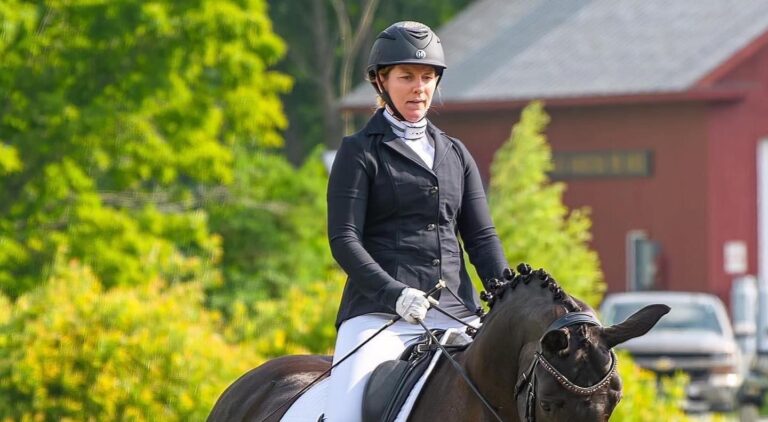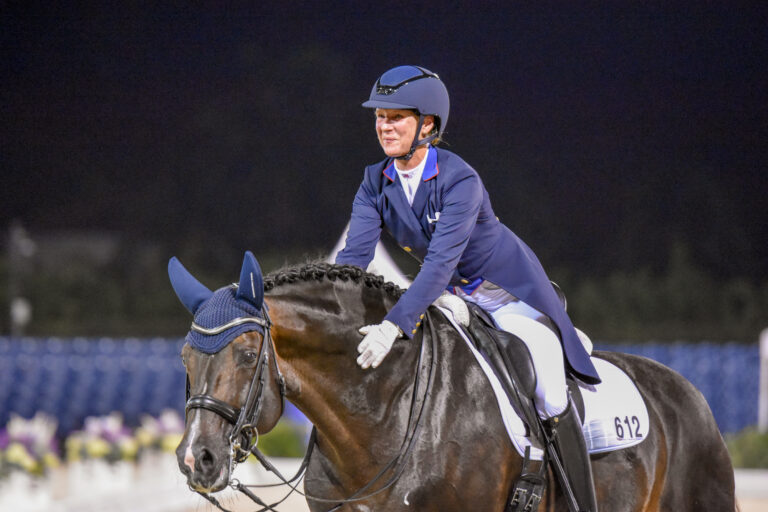Whether I am showing, training or teaching, I constantly think about balance and symmetry in the horse and rider. These qualities are crucial to the proper execution of every movement in dressage. To do well in dressage, you have to be aware of your body and your horse’s body at all times, and then you have to be able to calibrate your adjustments perfectly. While I am riding, I often visualize an overview of guide lines and squares intersecting my body and my horse. This “symmetrical thinking” is a powerful tool. It helps me quickly recognize and correct problems before they get big.
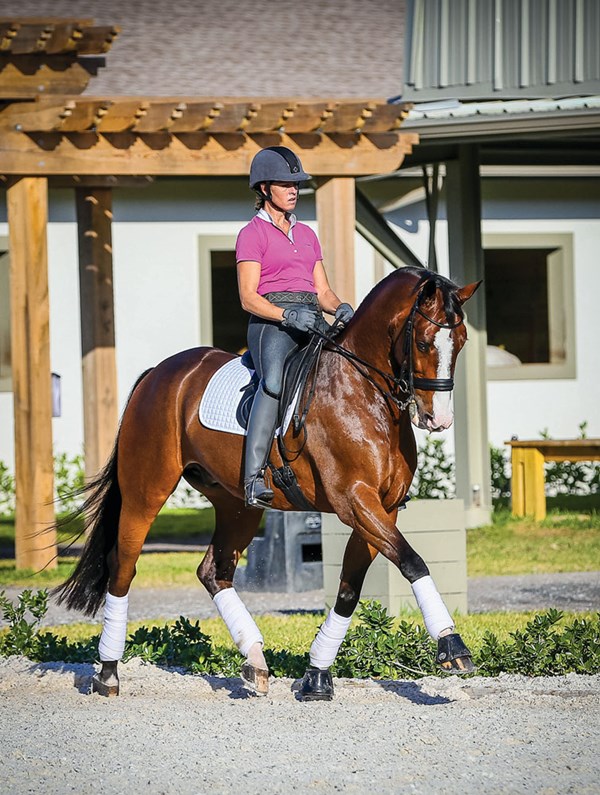
In this article, I will explain how I achieve symmetry in my riding as well as how I develop it in my students and horses.
Awareness of the Horse’s Position
Does your horse “motorcycle” through the turns? Does he fall in or out of circles? Does he lose his rhythm? These problems start with a loss of balance. Whether you are walking a 20-meter circle or performing a Grand Prix pirouette, making your horse level and balanced should always be a priority.
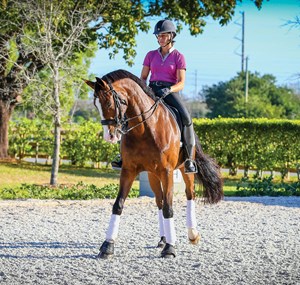
I find that I can detect balance problems faster when I visualize horizontal lines that intersect with my horse’s body. For example: Are the tips of my horse’s ears level? Are my horse’s hips level? Are his shoulders level? With these guide lines in place, I continually aid and adjust my horse in order to keep these imaginary levels parallel to the ground. By recognizing where to make micro-adjustments, I can prevent loss of balance before it affects our performance.
I also think about a line running down my horse’s spine. If I ride him up the quarterline, can I keep equal parts of his body on each side of the line? Can I keep his spine on the line when riding circles and other curved lines? Does he tend to travel with his hips to the right of the line and his shoulders to the left? When I am able to control the alignment of his spine, I can ride my horse on bending lines in an ideal balance.

Corners are a great place to work on these details. Do you go storming through your corners while thinking about the next long side? If so, you are missing a great opportunity to fine-tune your horse’s balance. When I ride through a corner, I imagine scales under my horse’s feet. Is he putting equal weight into each footstep? Is the line tracing the outside of his body nicely curved or are his shoulders falling inside or outside of the line?
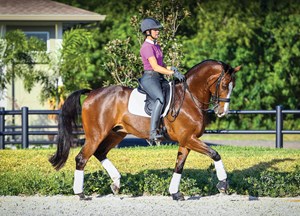
It’s natural for a horse to have some conformational asymmetries. If you don’t address these in your riding from the start, you risk developing problems down the road. For example, one of my clients bought a horse with a physical issue commonly known as the up/down foot. He had a high heel on the left front and a low heel on the right front. As a result, the muscling of his left shoulder was overdeveloped. He was a saddle-fitting nightmare because the saddle would constantly fall to the right. We had to use shims under his saddle on the right side in order to help it sit level. We worked with a farrier to get his feet as even as possible while respecting his natural conformation. Then we trained him to use his body in as symmetrical a way as possible. Through straight and balanced riding, we were able to rebuild his muscles so that they are now equal. Visually, he now looks like a well-proportioned horse, and his saddle doesn’t need shims to sit level anymore.
Make sure your horse is as comfortable in his body as possible. If you have continual problems with straightness, look for a physical cause. I don’t buy it when people say, “He always does this.” That doesn’t make it OK. I don’t believe it is in the horse’s nature to respond negatively to his rider. In my experience, evasions usually come from discomfort. A horse naturally tries to put himself in the most comfortable position.
Rider Position
Of course, balance starts with the rider. We must sit level at all times. It’s not fair to expect our horses to move freely when we cannot sit in balance on their backs. No body is perfect, so position is something that every rider can work on all the time.
Since your posture habits will have a direct effect on your position in the saddle, you might as well start by looking in the mirror at home. How squarely do you stand? Are your shoulders level? Is your head balanced on top or projected forward? Is your chest sagging? Do you jut one hip? Do you point one foot out more than the other? With a newfound awareness of your posture habits, you can work on your position all the time. Yoga and/or Pilates can help you take this awareness to the next level.
An old injury can also make it difficult to sit straight on a horse. A physical or sports therapist can design a workout to help you target your unique issues. Meanwhile, make sure your saddle is balanced and well fitted to you and your horse. Until your position is straighter, get regular saddle checkups to protect your horse’s back.
When I sit in the saddle, I begin by thinking about the horse’s spine in relation to my spine. The horse’s spine is about 2 inches wide. I try to place my spine directly on top of his spine and balance so that my spine is perpendicular to his. Then I make sure that my body is split 50/50 on either side of his spine, with my seat bones equally weighted.
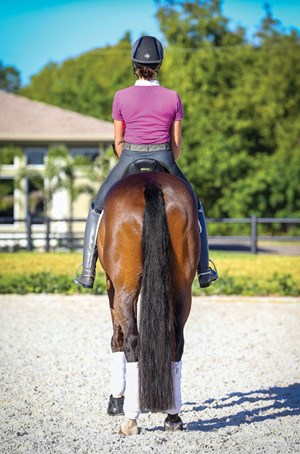
If you have a mirror in your arena, ride straight toward it. If you don’t have a mirror, have a friend watch or make a quick smartphone video for you.
Here are some things you can evaluate:
• Are your ears level?
• Are your shoulders level?
• Are your elbows level?
• Are your hands level?
• Are your hipbones level? I have made little Xs with masking tape to mark my students’ hipbones so that we can quickly spot when one hip is tilting up.
• Are your heels level?
Timing of the Aids
Sitting in symmetry is your neutral position. A dressage horse becomes sensitive to the aids because a symmetrical seat has no static; the tiniest aids can be heard clearly. Your job as a rider is to sit in symmetry and then learn how to give aids without ever sacrificing your center of balance.
When I ride, I have found that I have to analyze my horse’s responses and recalibrate my aids with every stride. I am always reorganizing my horse with tiny checks and balances. For example, if I put slight pressure on my inside stirrup to indicate bend and the horse responds, I return to sitting in symmetry again. If he does not respond, I have to assess why. My first question is: Did we start from a place of balance? It is pointless to ask the horse to attempt a movement if you don’t start from a place of balance.
Here is an example of how I might troubleshoot a problem. Let’s say you are going from trot to canter, and your horse doesn’t canter or he picks up an unbalanced canter. Your first thought should be to do a body check. Ask yourself: Was I level? Was I precise with my aid? Is there anything I was doing to cause my horse to tune me out? Was I nagging or giving too much information? Your second thought should be about your horse: Was he unbalanced? Was he falling in or was he on his forehand when I gave the aid?
If you are convinced that you and your horse were physically in balance, then it’s time to check your horse mentally. Maybe you need to get his attention. If so, then my third step is to make the aid clearer. Depending on the horse’s sensitivity, you can cluck or touch him with the whip to get his attention. Horses do have their own brains. My final problem-solving step will depend on the horse. Maybe he needs a sharper aid, maybe I need to find a way to make the exercise more challenging or maybe I need to break it down so he understands what I am asking.
The biggest mistake I see amateur riders make is to apply their aids too long and too strong. When you give an aid too strongly, it causes a lot of problems: It sacrifices your ability to sit symmetrically, it makes the horse dull and, ultimately, it can cause him to lose his balance. For example, pushing too hard with the inside leg can cause the inside leg to shorten, the seat to push out and the shoulders to lean in. This typically will cause a horse to fall in.
Ideally, you should give the appropriate aid and then return to your neutral position while you assess the horse’s response. An aid that lasts too long also blocks your horse’s flow. For example, a horse can respond to your leg aid only when his leg is lifting into the air. If you clamp your heel against him, he has to adapt to the unrelenting pressure by bracing, rushing or simply tuning you out.
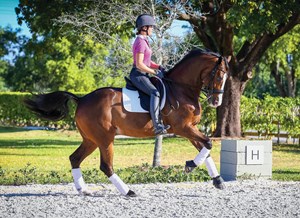
I like to slow things down to help my students get a feel for the timing of the aids and their release. Riding the horse at a slower pace allows a rider more time to give an aid correctly and to feel its effects. I also take power away until my students can keep their positions balanced and neutral. Gripping and balancing on the reins are bad habits that can start when riders attempt to ride more thrust than they can handle. A skilled rider with refined body awareness helps the horse learn to work in a symmetrical balance. Good riding results in less wear and tear on the horse’s body. We riders have a big responsibility because unbalanced horses have a higher risk of injury. This is why I recommend that novice riders seek regular instruction in order to stay on track. Also, if you are a novice, have your horse worked regularly by a rider who has the skills to help him develop his body evenly.
In this article I have attempted to get you to become more aware of horizontal balance and symmetry for you and your horse. Dressage riders expend a lot of energy thinking and talking about the longitudinal balance or, more simply, getting the horse to collect and move “uphill.” The uphill balance may be the holy grail of dressage, but the muscles have to be developed first. Symmetrical training of both horse and rider is the secret to success.
Take Your Time
It’s tempting to play with the powerful gaits offered by a young, big-moving horse. Resist the temptation. Don’t make him chase his own balance. Riding a youngster with more power than he can handle puts him at risk for injury and stresses him mentally. How much power is too much? Can you keep his rhythm consistent throughout the arena? Does he offer a fancy trot down the long side of the arena, but lose cadence in the corners? Before you ask for power, take time to develop your youngster’s balance, rhythm and maneuverability.
Find Your Balance
The Wii Balance Board—an accessory that goes with the Nintendo Wii video game console—is a great tool to help you find your center of gravity. It looks like a scale, but it has pressure sensors that can detect the distribution of your weight and balance in real time. For example, you might think you are standing perfectly centered, but the balance board reveals that you are standing heavier on one foot and leaning forward. In other words, it provides the hard-core feedback you need to perfect your balance. The Wii also offers several games to help you improve your balance awareness.
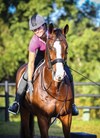
Lauren Sammis is a two-time U.S. dressage team medalist who earned team gold and individual silver at the Pan Am Games in 2007. She is also a USDF gold, silver and bronze medalist. Sammis runs a training and teaching business located in New Jersey and travels to Florida for the winter season (sammissales.com).


